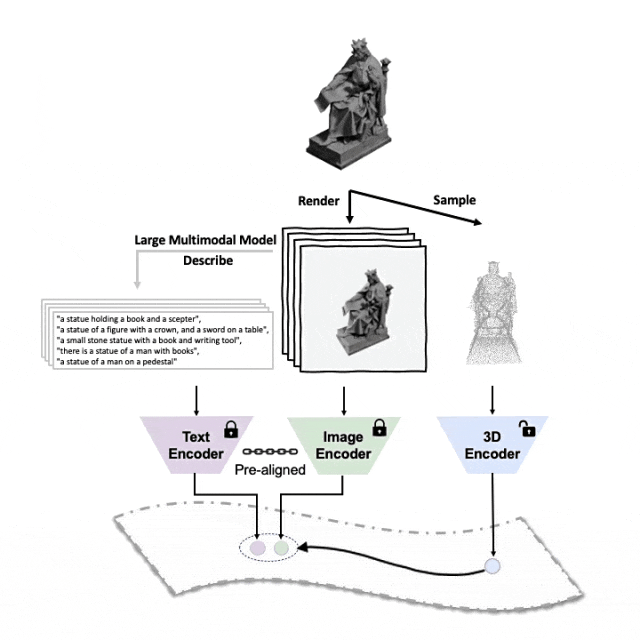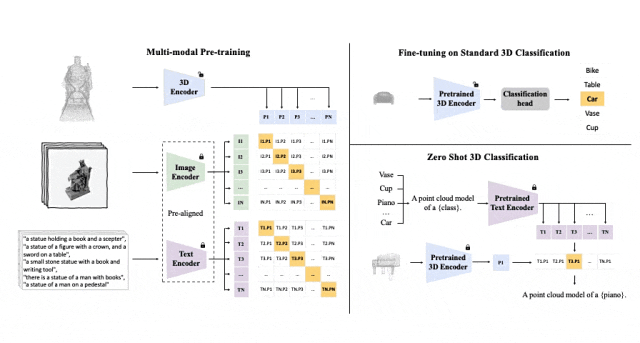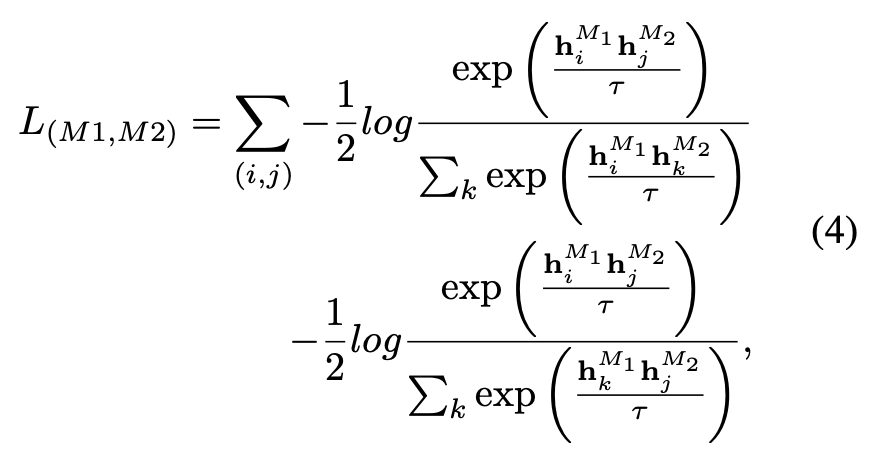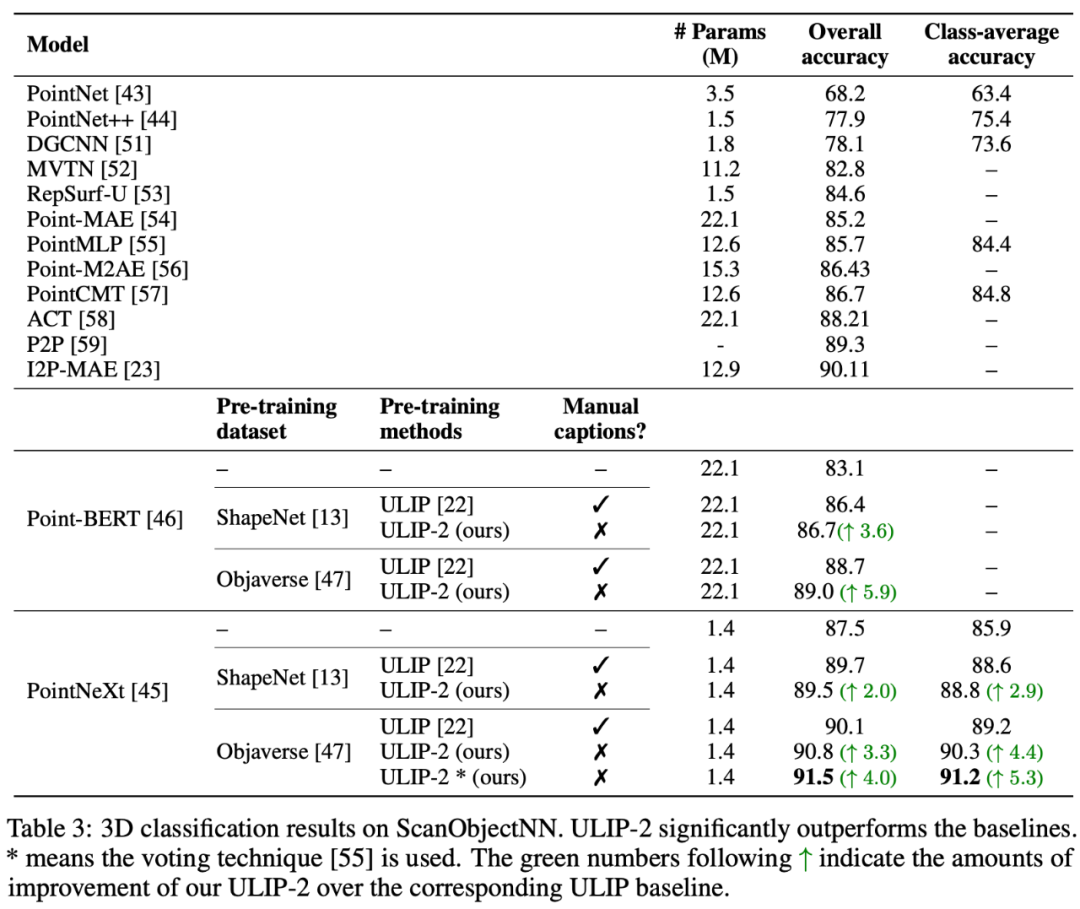
By aligning three-dimensional shapes, two-dimensional pictures and corresponding language descriptions, multi-modal pre-training methods also drive the development of 3D representation learning.
However, the existing multi-modal pre-training frameworkmethods of collecting data lack scalability, which greatly limits the potential of multi-modal learning. Among them, the most The main bottleneck lies in the scalability and comprehensiveness of language modalities.
Recently, Salesforce AI teamed up with Stanford University and the University of Texas at Austin to release the ULIP (CVP R2023) and ULIP-2 projects, which are leading a new chapter in 3D understanding. .

Paper link: https://arxiv.org/pdf/2212.05171.pdf
Paper link: https://arxiv.org/pdf/2305.08275.pdf
##Code link: https: //github.com/salesforce/ULIP
The researchers used a unique approach to pre-train the model using 3D point clouds, images and text, aligning them to A unified feature space. This approach achieves state-of-the-art results in 3D classification tasks and opens up new possibilities for cross-domain tasks such as image-to-3D retrieval.
And ULIP-2 makes this multi-modal pre-training possible without any manual annotation, thus enabling large-scale scalability.
ULIP-2 achieved significant performance improvements in the downstream zero-shot classification of ModelNet40, reaching the highest accuracy of 74.0%; on the real-world ScanObjectNN benchmark, it only used 1.4 million An overall accuracy of 91.5% was achieved with just one parameter, marking a breakthrough in scalable multimodal 3D representation learning without the need for human 3D annotation.

Schematic diagram of the pre-training framework for aligning these three features (3D, image, text)
The code and the released large-scale tri-modal data sets ("ULIP - Objaverse Triplets" and "ULIP - ShapeNet Triplets") have been open source.
Background3D understanding is an important part of the field of artificial intelligence, which allows machines to perceive and interact in three-dimensional space like humans. This capability has important applications in areas such as autonomous vehicles, robotics, virtual reality, and augmented reality.
However, 3D understanding has always faced huge challenges due to the complexity of processing and interpreting 3D data, as well as the cost of collecting and annotating 3D data.

##Tri-modal pre-training framework and its downstream tasks
ULIP (already accepted by CVPR2023) adopts a unique approach to pre-train the model using 3D point clouds, images and text, aligning them into a unified representation space .This approach achieves state-of-the-art results in 3D classification tasks and opens up new possibilities for cross-domain tasks such as image-to-3D retrieval.
The key to the success of ULIP is the use of pre-aligned image and text encoders, such as CLIP, which are pre-trained on a large number of image-text pairs.
These encoders align the features of the three modalities into a unified representation space, enabling the model to understand and classify 3D objects more effectively.
This improved 3D representation learning not only enhances the model’s understanding of 3D data, but also enables cross-modal applications such as zero-shot 3D classification and image-to-3D retrieval because the 3D encoder gains Multimodal context. The pre-training loss function of ULIP is as follows: In the default settings of ULIP, α is is set to 0, β and θ are set to 1, and the contrastive learning loss function between each two modes is defined as follows, where M1 and M2 refer to any two modes among the three modes: ULIP also conducted experiments on retrieval from image to 3D, and the results are as follows: The experimental results show that the ULIP pre-trained model has been able to learn meaningful multi-modal features between images and 3D point clouds. Surprisingly, compared to the other retrieved 3D models, the first retrieved 3D model is closest in appearance to the query image. For example, when we use images from different aircraft types (fighters and airliners) for retrieval (second and third rows), the closest 3D point cloud retrieved is still Subtle differences in query images are preserved. ##Here is a 3D object that generates multi-angle text descriptions Example. We first render 3D objects into 2D images from a set of views, and then use a large multi-modal model to generate descriptions for all generated images ULIP-2 in ULIP Basically, use large-scale multi-modal models to generate all-round corresponding language descriptions for 3D objects, thereby collecting scalable multi-modal pre-training data without any manual annotation, making the pre-training process and the trained model more efficient and enhanced its adaptability. ULIP-2’s method includes generating multi-angle and different language descriptions for each 3D object, and then using these descriptions to train the model, so that 3D objects, 2D images, and language descriptions can be combined Feature space alignment is consistent. This framework enables the creation of large tri-modal datasets without manual annotation, thereby fully utilizing the potential of multi-modal pre-training. ULIP-2 also released the large-scale three-modal data sets generated: "ULIP - Objaverse Triplets" and "ULIP - ShapeNet Triplets". Some statistical data of two tri-modal datasets The ULIP series has achieved amazing results in multi-modal downstream tasks and fine-tuning experiments on 3D expressions. In particular, the pre-training in ULIP-2 can be achieved without any manual annotation. of. ULIP-2 achieved significant improvements (74.0% top-1 accuracy) on the downstream zero-shot classification task of ModelNet40; in the real-world ScanObjectNN benchmark, it achieved An overall accuracy of 91.5% was achieved with only 1.4M parameters, marking a breakthrough in scalable multi-modal 3D representation learning without the need for manual 3D annotation. Both papers conducted detailed ablation experiments. In "ULIP: Learning a Unified Representation of Language, Images, and Point Clouds for 3D Understanding", since the pre-training framework of ULIP involves the participation of three modalities, the author used experiments to explore whether it is only Is it better to align two of the modes or to align all three modes? The experimental results are as follows: As can be seen from the experimental results, In different 3D backbones, aligning three modalities is better than aligning only two modalities, which also proves the rationality of ULIP's pre-training framework. In "ULIP-2: Towards Scalable Multimodal Pre-training for 3D Understanding", the author explores the impact of different large-scale multimodal models on the pre-training framework. The results are as follows: The experimental results can be seen that the effect of ULIP-2 framework pre-training can be upgraded with the use of large-scale multi-modal models. And promotion has a certain degree of growth. In ULIP-2, the author also explored how using different numbers of views to generate the tri-modal data set would affect the overall pre-training performance. The experimental results are as follows: #The experimental results show that as the number of perspectives used increases, the effect of zero-shot classification of the pre-trained model will also increase. This also supports the point in ULIP-2 that a more comprehensive and diverse language description will have a positive effect on multi-modal pre-training. In addition, ULIP-2 also explored the impact of language descriptions of different topk sorted by CLIP on multi-modal pre-training. The experimental results are as follows: The experimental results show that the ULIP-2 framework has a certain degree of robustness to different topk. Top 5 is used as the default setting in the paper. The ULIP project (CVPR2023) and ULIP-2 jointly released by Salesforce AI, Stanford University, and the University of Texas at Austin are changing the field of 3D understanding. ULIP aligns different modalities into a unified space, enhancing 3D feature learning and enabling cross-modal applications. ULIP-2 is further developed to generate a holistic language description for 3D objects, create and open source a large number of three-modal data sets, and this process does not require manual annotation. These projects set new benchmarks in 3D understanding, paving the way for a future where machines truly understand our three-dimensional world. Salesforce AI: Le Xue (Xue Le), Mingfei Gao (Gao Mingfei), Chen Xing (Xingchen), Ning Yu (Yu Ning), Shu Zhang (张捍), Junnan Li (李俊 Nan), Caiming Xiong (Xiong Caiming), Ran Xu (Xu Ran), Juan Carlos niebles, Silvio Savarese. Stanford University: Prof. Silvio Savarese, Prof. Juan Carlos Niebles, Prof. Jiajun Wu(Wu Jiajun). UT Austin: Prof. Roberto Martín-Martín. 


ULIP-2






Conclusion
Team
The above is the detailed content of No need to label data, '3D understanding' enters the era of multi-modal pre-training! ULIP series is fully open source and refreshes SOTA. For more information, please follow other related articles on the PHP Chinese website!
 How do I set up WeChat to require my consent when people add me to a group?
How do I set up WeChat to require my consent when people add me to a group?
 Word single page changes paper orientation
Word single page changes paper orientation
 The latest prices of the top ten virtual currencies
The latest prices of the top ten virtual currencies
 What to do if temporary file rename fails
What to do if temporary file rename fails
 What does activity mean?
What does activity mean?
 What is a relational database
What is a relational database
 What should I do if my windows license is about to expire?
What should I do if my windows license is about to expire?
 Check friends' online status on TikTok
Check friends' online status on TikTok




